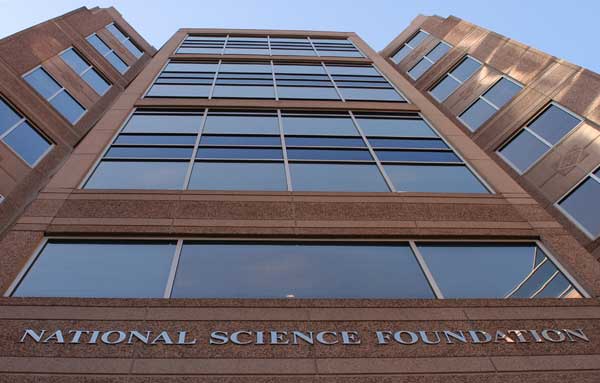
The National Science Foundation presented its 2015 budget request to Congress and unveiled a strategic plan that includes continued research support at labs across the country, including the Nanostructures Laboratory at North Carolina State University, pictured above. Credit: National Science Foundation.
We recently reported on President Obama’s FY 2015 budget proposal, which gave federal R&D funding a slight 1.2-percent bump.
Despite a lukewarm reception to the mostly flat research spending proposal, last week, Cora Marrett, acting director of the National Science Foundation (NSF), formally presented NSF’s $7.3-billion budget request to Congress.
According to an NSF news release, the spending plan—which represents a roughly 1-percent increase over 2014 appropriations—“supports investments in fundamental research across all scientific disciplines, engineering, and education that continue to enhance our national economy, security, and quality of life.” (To view the detailed request in full, click here.)
Highlights from Marrett’s remarks (and the accompanying slides) reveal further insight into where those dollars will be spent as well as how they align with the NSF’s strategic objectives.
- Maintain NSF’s “core mission” of fundamental research “Based on the experience of prior years, we can estimate that about 94 percent will be spent on supporting research, education, and facilities, meaning that the vast majority of our budget actually goes back to states and localities through the grants and awards we make. Overall, we expect to receive about 50,000 grant proposals during the year, from which our competitive merit review process will result in funding about 11,000 awards. NSF provides 24 percent of total federal support of academic basic research in all science and engineering fields in the U.S., meaning we expect some 2,000 U.S. colleges, universities, and other institutions to receive NSF funding. Each year, NSF awards thousands of grants that engage the talents of about 300,000 researchers, postdoctoral fellows, trainees, teachers, and students. That support is distributed among individuals, teams, centers, and major facilities across a vast array of disciplines. Because of our comprehensive commitment to empower discoveries, NSF helps keep our nation at the very forefront of the world’s science-and-engineering enterprise.”
- Investments in clean energy technology “For FY 2015, NSF proposes to invest $362 million in fundamental research that will lead to future clean energy and energy efficient technologies. Specific activities include research related to sustainability science and engineering, including the conversion, storage, and distribution of diverse power sources, and the science and engineering of energy materials, energy use, and energy efficiency.”
- Investments in manufacturing, “data-enabled science and engineering,” and big data “Cyber-enabled Materials, Manufacturing, and Smart Systems (pdf)—or CEMMSS—will receive $213 million in this budget. CEMMSS aims to integrate a number of science and engineering activities across the Foundation, including breakthrough materials, advanced manufacturing, robotics and cyber-physical systems. We will invest $ 125 million in our Cyberinfrastructure Framework for 21st Century Science, Engineering, and Education—or CIF21. You understand why we have to do these acronyms; to remember all these words would be a bit difficult. CIF21 will accelerate and transform the process of scientific discovery and innovation by providing advanced cyberinfrastructure and new capabilities in computational and data-enabled science and engineering. In FY 2015, NSF will continue to lead the Big Data program, which strives to enable breakthrough discoveries and innovation in science, engineering, medicine, commerce, education, and national security.”
- Improving undergraduate STEM education “The Improving Undergraduate STEM Education—or IUSE—program will receive $118 million for a more extensive coordination of our undergraduate STEM education investments. This is within a framework that’s designed to accelerate improvement and measurable impact of our undergraduate STEM education programs.”
- Looking at the larger picture, looking toward the future “With this budget request, the Administration has conveyed its determination to build on the nation’s history of success in leading-edge discovery and innovation. … Now although today’s primary focus is the presentation of the budget request, we are also releasing the 2014-2018 Strategic Plan for NSF—the title of it is “Investing in Science, Engineering, and Education for the Nation’s Future.”
If you don’t plan on reading the strategic plan in full, here are the NSF’s three strategic goals that will guide the organization through 2018:
- Transform the Frontiers of Science and Engineering Invest in fundamental research to ensure significant continuing advances across science, engineering, and education. Integrate education and research to support development of a diverse STEM workforce with cutting-edge capabilities. Provide world-class research infrastructure to enable major scientific advances.
- Stimulate Innovation and Address Societal Needs through Research and Education Strengthen the links between fundamental research and societal needs through investments and partnerships. Build the capacity of the nation to address societal challenges using a suite of formal, informal, and broadly available STEM educational mechanisms.
- Excel as a Federal Science Agency Build an increasingly diverse, engaged, and high-performing workforce by fostering excellence in recruitment, training, leadership, and management of human capital. Use effective methods and innovative solutions to achieve excellence in accomplishing the agency’s mission.

Late last week, the US Senate voted to confirm astrophysicist France Córdova, a former NASA chief scientist, as head of the NSF. She is just the second woman to lead the agency. Credit: NASA.
To view Marrett’s presentation, NSF’s detailed budget request, or the 2014-2018 strategic plan, head on over to the NSF website. (Just days after presenting the request, the US Senate voted to confirm France Córdova to lead the agency. Read more about her appointment here.)
In other budget news, Obama’s proposed plan, which included $56 billion in discretionary spending for defense, nondefense, and R&D funding, already has been nixed by several prominent members of Congress. According to Bloomberg, Representative Hal Rogers, chairman of the House Appropriations Committee, won’t consider the request—which exceeds the spending limits established in December—and has “specifically ruled out considering spending for the Opportunity, Growth and Security Initiative.” Meanwhile, Politico reports that House Speaker John Boehner has categorized the proposal as “perhaps his most irresponsible budget yet.”
Debate (and updates)—as expected—will continue.
Feature Image Credit: National Science Foundation

